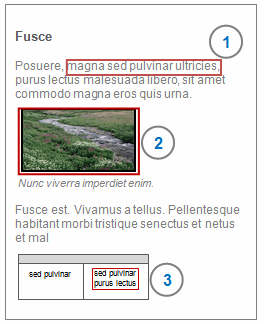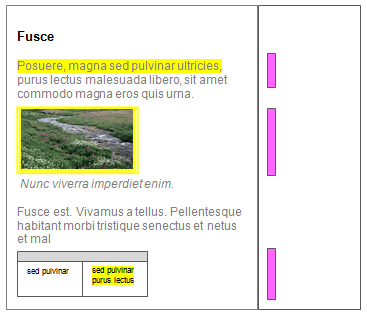
This topic will get you started with coding documents and PDFs—refer to More manual coding techniques for more information about coding.
What do you want to do?
In document sources you can select and code text or images:

1 Select and code portions of text—a few words, a whole passage or all text in the source. Click and drag to select the text you want to code. You can also double-click to select a word and triple-click to select a paragraph.
2 Select and code entire images.
3 Select and code text or images in tables
NOTE If you have a collection of structured documents, you can use automatic coding techniques to speed up coding. For example, if you are working with a collection of interview transcripts, you can automatically code the contents based on heading styles or paragraph number—refer to Automatic coding in document sources for more information.
You can select and code text or regions of the page:

1 Select and code portions of text. By default, PDFs open in text selection mode—you can click and drag to select the text you want to code. You can also double-click to select a word and triple-click to select a line.
2 Select and code regions of a page. If you switch to region selection, you can click on an image to select it, or click and drag to select a rectangular region of the page. When you code a region, you are coding an image selection—if the region contains text, you are coding an image of text (rather than text).
To switch between text and region selection—on the Home tab, in the Editing group, under PDF Selection, click Text or Region.
NOTE
PDFs that are created by scanning paper documents may contain only images—each page is a single image. if you import the PDF into NVivo, you will find that there is no text in the page to select and code. You can select and code regions of the page, however you are coding a image selection and you cannot use Text Search or Word Frequency queries to explore the text. If you prefer to work with text (rather than images of text), then you should consider using optical character recognition (OCR) to convert the scanned images to text (before you import the PDF files into NVivo).
NVivo tries to determine the order of text on a PDF page, however when you select text, you may find that the text on the page is not sequenced as you expect.
If you are using NVivo 9.0 (rather than NVivo 9.1 or later), PDF files are imported as document sources. NVivo 9.1 changes the way you work with PDF files—refer to What's new in NVivo 9 for more information. If you are still using NVivo 9.0, we recommend you update your software—refer to Software updates for more information
In externals and memos (just like in documents), you can select and code text and images—refer to Understand what you can code in documents for more information,
Select the content you want to code.
On the Analyze tab, in the Coding group, under Code Selection At, click New Node.

The New Node dialog box is displayed.
(Optional) To choose where you want to store the node—in the Location box, click the Select button and select the location.
Enter a name for the node.
(Optional) Enter a description of the node.
Click OK.
NOTE If you want to code at a node that already exists, click Existing Nodes, under Code Selection At, and select the relevant node. You can also drag and drop content on existing nodes—refer to More manual coding techniques for more detailed information about coding.
To see what has been coded in a source, you can
Turn on coding highlight—on the View tab in the Coding group, click the arrow next to Highlight, and then select a highlight option. Coded content is highlighted in yellow:

Turn on coding stripes—on the View tab in the Coding group, click the arrow next to Coding Stripes, and then select an option. Coding stripes are displayed on the right of the source:

For more detailed information on coding highlight and coding stripes—refer to Highlight coding or display coding stripes.
You can open a node to see all the coded references:
In Navigation View, locate and click the folder that contains the node you want inspect.
In List View, double-click the node. The node opens in Detail View.
On the right of the node, click the Text tab or PDF tab.
The Text tab shows content coded in documents, externals and memos. The PDF tab shows content coded in PDF sources.